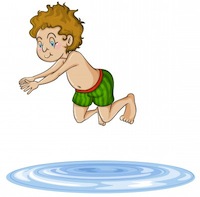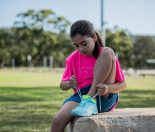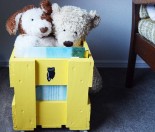Choosing the right togs and swim bags for your children can be a challenge. We give you some tips for your shopping trip in our Togs and Swim Bags article.
When it comes to buying children’s swimwear, you really do get what you pay for – so where and what you buy needs some careful thought. You’ll need to consider just how much time your child will spend wearing togs and, strange as this may sound, what exactly they’ll be doing. Togs for swimming lessons usually look quite different to togs for the beach, and if your child hardly steps foot in the water, you may not want to spend as much as someone whose child lives in the pool. Whatever your priorities, this simple guide will help you make a decision that’s right for you.
Swimwear
Sun Smart
When I was a child we used to spend hours on the beach with no sun block, and just assumed that getting blisteringly burnt was a part of summer. Thankfully that’s not the case nowadays, and not only can we protect our children with sun block, but sun smart swimwear as well.
Togs which cover the shoulders, arms, neck and tops of the legs are great if your child will be spending a lot of time in the sun, and are particularly good for littlies who are not so much swimming, as paddling. Most department stores sell complete sun suits in small sizes (up to about 8 years), and tops and bottoms are available for older children. Some specialist children’s-wear stores also sell sun suits, and there are plenty of specialist swimwear providers online.
If you’re choosing togs for their sunsmart quality, then how much of the child’s body they cover is not the only thing you need to look out for. You also need to check the UV rating of the fabric, because believe it or not, it is possible to get sun burnt through your togs. The New Zealand / Australian Safety Standard recommend fabrics with a SPF of 50+, and they should also have a 100% UV safety rating. While togs do not have to comply with this standard, the manufacturers are liable for huge fines if they misrepresent the sun smart quality of their garment. If they don’t advertise their SPF or UV rating, then chances are it’s not very good.
Chlorine Resistant
Being ‘chlorine-resistant’ is not just a marketing buzzword designed to make you spend more money; it really is a must-have if you want your child’s togs to last. Experiments on different types of fabric have shown that chlorine literally eats away at non-resistant material – in fact, the non-resistant types of fabric will literally start disappearing before your eyes!
Obviously, the chlorine levels in pools are not going to eat your child’s togs right off their back, but it does slowly penetrate the fabric and will destroy the elasticity. Even relatively tight blends like nylon / lycra will eventually end up with a ‘saggy bottom’ once the chlorine starts its work. Chlorine is also responsible for beautiful bright colours fading into pale pastel shades, or one colour running into the next.
If your child’s togs are not chlorine resistant, you can prolong their life a little bit by taking extra special care with washing. Make sure the togs are rinsed out in cold water immediately after use, then washed in a cold wash and dried in the shade. Chlorine resistant swimwear needs no special attention, and can just be thrown in the wash along with everything else.
Purpose Specific Fabric
Now this may sound a little silly, but believe it or not, not all swimwear is designed to be swum in. Cotton blends may look pretty at first, but once they get wet they pull and stretch right out of shape. Look for purpose-made swimwear which has been made with nylon / lycra or 100% polyester, as these are designed for the water and have far less stretch. Swimwear which uses all-way stretch fabric will grow with your child, and last more than one season.
Swim Goggles
Swim goggles come in all sorts of styles, and while most have adjustable straps, they are definitely not one-size-fits-all. When buying swim goggles for your child, you should take into account the size and shape of their face, and what sort of swimming they will be doing. Try to purchase the goggles from a specialist swim or sports store where they will have styles available for your child to try on first. There is nothing more frustrating than buying goggles which your child won’t wear because they’re uncomfortable, or they leak.
In terms of goggles, you generally get what you pay for, so how much you spend will largely depend on whether your child is learning to swim, in competitive training, or just mucking about in the family pool. Here are some things to look out for when making your purchase – the further down the list you go, the more ‘serious’ goggles you’ll be buying.
- Shatter resistant lenses
- Soft seals around the eyes (neoprene foam or silicone)
- Easily adjusted head strap
- Adjustable nose piece
- Shape of the lens
- Fog resistant lenses
- Single or split head strap
If your child is swimming competitively, check out our guide to ‘Competitive Swimming’ (coming soon) for a more detailed list of goggle pros and cons.
Swim Caps
There are 2 basic types of swimming caps – latex and silicone. Generally speaking silicone versions will last longer and be more comfortable, but either is fine. Usually swimming caps are only needed if your child starts swimming seriously, and are available through their swimming club. If your child is not a competitive swimmer but still wants a swimming cap, you can purchase them from swim stores at public pools, online, or through major sports shops.
Swimming Bags
Whether your child is swimming at school or at a club, they are going to need a swimming bag to keep and carry their togs in. There are plenty of versions available, all with different features, and of course price. When making your choice, consider the following:
Fabric
Ideally your child’s swimming bag should be made from waterproof fabric, so that wet towels and togs don’t damage school books, car seats, (or their bedroom carpet!). Watch out for ‘shower proof’ material which doesn’t hold the water from sopping towels, and make sure the whole thing can be thrown in the washing machine if needed.
Size
While swimming bags are designed to hold togs and towels, it is useful if it’s big enough to hold your child’s clothes and shoes as well. This way they have somewhere to put their belongings while they are in the pool. If your child is involved in competitive swimming or other water sports, find a bag that holds all of their gear, so that items don’t get lost or accidentally left behind.
Pockets
Having two sections in your swimming bag is useful for separating wet and dry items. It’s all very well for your child to put their clothes in their bag while swimming, but not if they then put their dirty shoes on top. Wet and dry sections allow your child to keep everything clean. Smaller pockets for things like goggles and concession cards are also useful.
Straps
Most swimming bags have a drawstring closure, and often these drawstrings double as straps. While this is fine for short trips to and from the school pool, you may want to consider a bag with separate straps if your child is more involved in swimming. A bag with a separate strap is more likely to carry the weight of extra gear, and makes it possible for your child to carry their bag safely and comfortably while walking or biking to practice.
Clips
While it’s not a necessity, buying a carabineer clip for your child’s swimming bag can save a lot of time at the lost property bay. They simply clip their swimming bag to their school bag, and it won’t get left hanging in the cloak room at the end of the day.
Accessories
The list of swimming accessories is literally endless, and includes specific ‘learn to swim’ equipment, as well as plenty of items which are ‘just for fun’. Our ‘Competitive Swimming’ and ‘Pool Toys’ articles (coming soon) will give you more details about specific items, but if you’re looking for something to buy your little water lover, these ideas are a great place to start. Remember to keep in mind the age and stage of your child, and check any safety recommendations at the time of purchase. What about…
- Arm Bands
- Flutter or Kick Boards
- Foam Noodles
- Water ‘seats’ or ‘ride-ons’
- Water rings
- Ear plugs
- Nose clips
- Tog Bags
- Flippers or fins
- Finger or hand paddles
- Weighted rings (for them to dive for)
- Floating Toys
- Blow up balls
- Water proof wristbands which hold money or keys while in the pool
- Sports toys like volleyball nets or floating basketball hoops
- Hooded Towels






